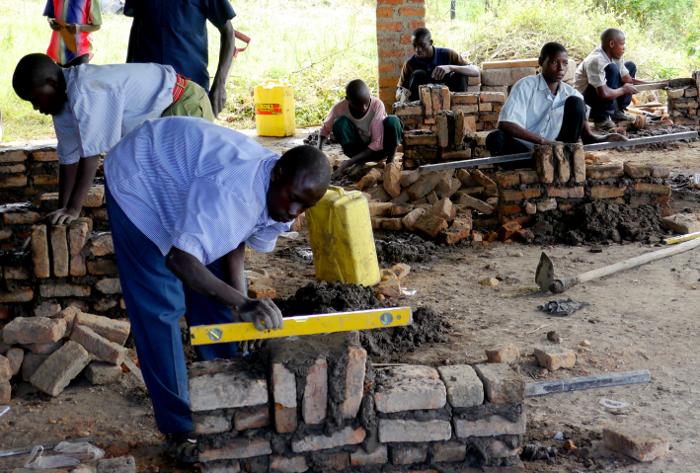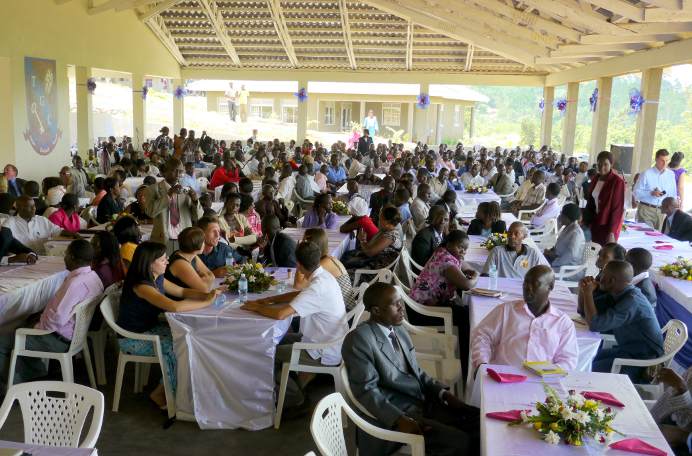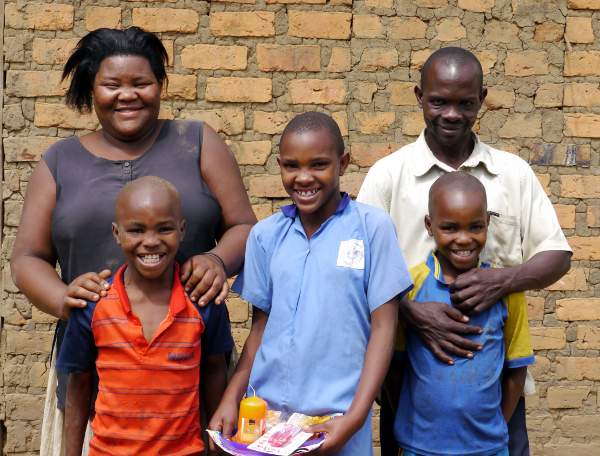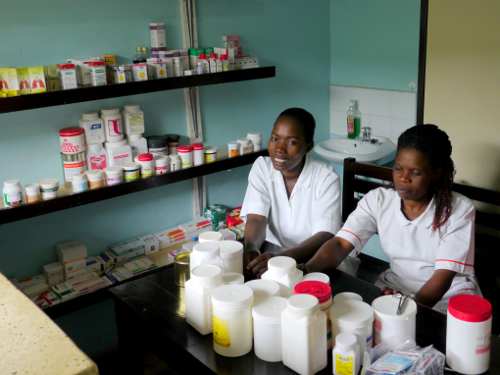March 2011
Bram Moolenaar, treasurer of ICCF Holland, visited the Kibaale Children's
Centre in March 2011. This is his report.
Click on the images below for an enlargement.
You can find many more pictures on
Picasa.
There is also a
print version of the report
Change of leadership
Over the years the project has added many responsibilities and the management
team has been constantly growing to handle this. Most of the time the
director overseeing the staff has been a Canadian. Over the years a lot of
experience has been transferred from foreign leaders to the Ugandan staff.
Finally a decision has been made to promote the headmaster to become the new
director. Peter Ochulu is now overseeing all the work in Kibaale.
I have talked with Peter and he told me that his vision is that, if we can
continue teaching the children and increasing the level of education, in ten
years time we will have a new generation of parents. Parents that are
responsible and know how to raise their children properly. And hopefully also
have the means to put their children in school, without a sponsor helping out.
I certainly hope Peter is right! We still have many years to go, but it's
indeed looking hopeful.
The Canadian volunteers now live in Masaka, at the new Timothy center. A few
times per week they go to Kibaale to help with the work there, and especially
to take care of money. Our project is one of the biggest employers in Rakai
district, handling the finances is a big responsibility, also towards our
sponsors and donors. We must make sure the money is well spent. I'm not
saying we cannot trust our Ugandan staff, it's difficult for anyone to carry
the responsibility.
|
|
|

The busy class for bricklaying in the vocational school.
|

350 guests at the official opening of the Timothy center.
|
|
|
Timothy center grand opening
The reason I visited Uganda at this specific date was that the brand new
girl's college was to be opened. And a big event it was! More than 350
people joined us, from leaders in the local government, through donors from
Canada to the builders who worked hard to get it ready in time. They all had
a very good lunch: matoke, chicken, rice, spinach, etc. I only took a bit of
everything, and it indeed was very tasty. Ugandans are used to filling their
plate "as much as will fit", and so they did! Compliments to the catering.
The school is impressive. There are spacious classrooms, nice dorms,
organized offices and decorated stairs and pathways between them.
Special attention has been given to making it
both comfortable and look attractive. The terrain helps with that, it has a
slope which provides a nice view from most places. The roofs are made with a
special kind of iron sheet that makes it look like tiles. And all this didn't
cost much extra. Most of the funds were needed for making the site ready for
building, as it was all grass and bush before. The funds needed for building
the school are covered by a few special donations.
Because of the slope a water management system was put in place where
rainwater tanks are on the higher grounds, providing water to buildings that
are lower just by gravity. An attempt was made to install solar power, but it
turned out to be too big of an investment to run the whole school from it.
Bringing in power lines is cheaper. Uganda generates hydro power, thus this
is still environment friendly. The solar power now functions as a backup,
together with a standby generator, to handle the frequent power
failures.
|
Twenty one girls have started their A-levels studies. For now it will be
girls only, a decision when boys will be starting is to be made later. There
also is a discussion about the location, putting boys and girls together in
one boarding school is frowned upon by some. I know it indeed can cause
problems, but keeping boys and girls separate is very unnatural and old
fashioned. It's better to deal with a known problem than to have them meet
somewhere else that is out of our sight. Well, that's just my personal
opinion.
It's wonderful to see that we can extend our education program above the
secondary level. The goal is not to just provide good education so that they
can go to university, but also make these children responsible and
well-behaving adults that will be the leaders for building up Uganda.
|
|
|

Since this is a boarding school the girls need a place to stay. The dorms
have real working showers, unique for Uganda!
|

I have visted Nankya Irene and her family.
|
|
|
Children
For two days while I was in Kibaale the school was closed for elections and
international womens day. The project is quite boring then, nothing much
going on. But the other days the school opened, and immediately children are
everywhere. Running to be on time for class, singing in the distance, or
playing on the field. That's when it is clear who we are doing all this
work for.
As usual I also visited several sponsored children at home. There has been
much progress in Uganda, but the children we sponsor are from needy families.
Denis, for example, still lives in the same house as ten years ago and it's
starting to show its age. Both his parents have passed away, there is only an
uncle that lives nearby who is their guardian. He is away very often and
then Denis has to take care of his siblings, since he is the oldest.
Other homes are similar. Irene does have both her parents, but their piece
of land is very small. They barely manage to grow food to feed the children.
The father tries hard, he even managed to produce bricks and rebuild the
house, using just local materials. But windows cost money, which they don't
have, so the house is very dark inside. There are no funds left to send the
children to school, so that's where we need to help out.
|
Clinic
The clinic building didn't change, but it's certainly fuller. A
container with medical supplies was received from the Netherlands. All the
store rooms are now filled with syringes, bandages and instruments. This is
a great help, the running cost of the clinic went quit a bit over budget
last year. And we certainly don't want to send people away because they can't
pay for the treatment that can save their lives.
Malaria is still the most common disease. When not treated properly the
patient has a high chance of dying. For the week I was in Uganda I could take
prophylaxes to avoid getting malaria, but for the locals the only way is
to treat it when it happens. Both with medicine and by being on drip to
regain strength. I certainly hope a vaccination against malaria will soon be
found.
|
|
|

The pharmacy at the clinic.
|
Conclusion
The project is doing well! We are helping hundreds of children to get a
better life. The daily work is now all done by Ugandans and we have
confidence we can keep the school and all the other departments running. It
is actually amazing that this project just keeps getting better.
Bram Moolenaar
many more pictures on Picasa
top
|

